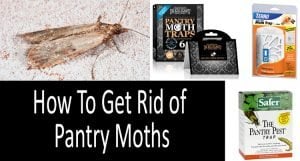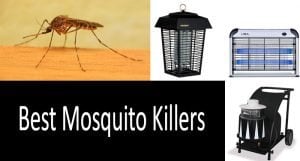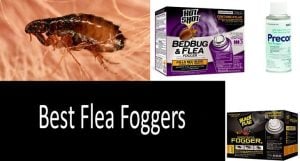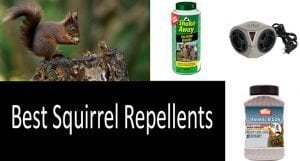What is the best way to get rid of no-see-ums? There are two effective solutions: repelling and trapping. Traps can be of two types based on how they attract no-see-ums. The most effective ones are those emitting carbon dioxide (CO2), a gas exhaled by humans and animals. By mimicking a mammal’s breathing, it draws no-see-ums in the trap, where they die from dehydration. Another type of trap utilizes UV light as a lure. While being less effective compared to CO2 traps, UV light traps are safer and can be used anywhere, including indoors. The captured insects are then electrocuted by an electric grid. As for repellents, they can be divided into two categories according to their application methods. Insecticides labeled for skin applications are generally based on DEET or Picaridin. The former is more powerful while the latter is considered to be less toxic. Sprays that are designed to be applied only to clothes contain Permethrin.
No-see-ums have plenty of names, such as biting midges or biting gnats, sand flies, punkies, pinyon gnats… All of them have different colloquialisms not only across the world but even across the U.S.A. These small biting midges don’t leave anyone alone simply because they can see and bite you painfully and you can’t even smash them because they are so tiny. What are they? How can you stop them? In this review, we’ll focus on the scientists’ opinions on how to get rid of no-see-ums, will determine the best repellent sprays, traps, zappers and protective clothing and will find out why the no-see-ums’ bites are so painful and dangerous.
- Scientists’ Advice about How to Get Rid of No-See-Ums
- The Best CO2 Trap
- The Best Bug Zapper
- Top-4 Best Repellent Sprays and Wipes
- Special Protective Clothing
- 7 Tips on How to Prevent No-See-Ums’ Bites
No-see-ums are tiny ferocious midges belonging to Ceratopogonidae. Their size does not exceed 1/16 of an inch, but despite this, their miniscule jaws can cause severe pain when they bite. What is interesting is that both males and females feed on the flower nectar, but the females must drink the blood of warm-blooded animals to be able to lay eggs. The larvae can only develop in a moist environment: in any still water, on the banks of the rivers and bonds, in the marshes or mud, on the decaying organic matter, dirt, garbage, inside the wet tree hollows, and in tropical climates, even in plants that contain large percentage of water.
Should favorable conditions be created for larvae, the number of adult insects will hit a critical point by May (if it’s warm) and will last till the end of the summer. Although certain species are active during the day, most of these biting midges feast at dawn and dusk, just like other gnats.
How can you combat these invisible monsters? Previously, the specialists would ditch and drain wetlands to destroy the larvae of these insects; nowadays such a method is barely used because of the large-scale spread of no-see-ums. University of Missouri Extension experts don’t have good news either as they state that “effective control is difficult.” The North Carolina Extension IPM Program specialists say that “Spray programs similar to those for mosquitoes are largely ineffective as more adult midges will invade the area once the pesticides diminish. Personal protection using repellents is a better choice if you’re going to be outdoors in areas with high populations of biting midges.” That’s why this method is simply a waste of money.
It’s not that pessimistic though, as there are some effective methods for getting rid of no-see-ums, including CO2 & UV luring and consequent killing, repellent use, window screens and special clothes. We’ll describe each of them in detail.
CO2 luring is human respiration imitation. On a large scale, removal trapping is conducted using CO2 as an attractant to lure the biting midges to an insecticide-treated target where they are killed. Research from the University of Florida, Institute of Food and Agricultural Sciences Florida Medical Entomology Laboratory has shown that biting midge populations were reduced in test areas of Vero Beach and Boynton Beach, FL, and Castaway Cay, Bahamas.
From these facts, we can conclude that CO2 insect traps are the most sensible option. They lure the insects with CO2 and UV light, and then suck them with a powerful fan into an internal compartment where the victims die of dehydration.
UV luring. Devices called bug zappers attract no-see-ums and other pest insects with UV light and electrocute them. If a bug zapper installed indoors, a chance of being bitten will likely to be brought down to a minimum. It will remove no-see-ums, mosquitoes, gnats, flies, clothes moths and other flying insects from your house.
Repellent Sprays. Although certain scientists believe that in this case any repellents are absolutely useless, most of the entomologists bet on DEET-containing repellents. Agriculture & Natural Resources University of Arizona Cooperative Extension specialists reckon that “Insect repellents containing DEET typically used against mosquitoes are also labeled for use against biting midges. Botanical insect repellents (those containing citronella, eucalyptus, and other plant extracts) may also provide some protection”. The scientific community agrees with them, naming DEET-based repellents the best protection against no-see-ums.DEET is not the only trustworthy substance, as the University of Maine Cooperative Extension experts also recommend using Picaridin-based repellents against biting midges. Picaridin is just as effective as DEET, and it is less toxic and relatively odorless (unlike DEET), and does not cause irritation or damage synthetic materials.
Insect protective clothing. These small creatures can easily fly under loose clothing and suck your blood, so for individual outdoor protection, you’ll need special clothing (head nets, jackets, and pants) made from no-see-um proof netting.Now that we have found out how to get rid of these tiny blood-suckers, let’s check out the traps and repellents that are best-suited for this purpose. Below, you’ll see the ones that users consider to be most effective in this case.
The Best CO2 Trap
The scientists have found out that just like with mosquitoes, CO2 can be used to lure biting midges and kill them afterwards. Most of such units are quite pricey so we’ve found an affordable option covering up to 300 sq ft. You can also take it along when travelling if you know that these blood-suckers are a real threat at your destination.
1. DynaTrap DT150 Indoor Insect Trap with UV Light Mosquito Repellent

The Dynatrap Ultralight Insect and Mosquito Trap is the most renowned CO2 insect trap to cover up to 300 sq. ft. It traps midges, sand flies, gnats, flies, mosquitoes, and other flying insects, including flies, wasps and beetles. Just like the electric bug zappers, it lures the insects with the warm light of a UV lamp, and it also has an additional feature: it mimics human breath! This is the result of UV light and special titanium dioxide-coated surface of the device interaction.
What happens next? After being lured with the light and breath, an insect encounters a powerful but quiet fan which sucks it inside the grid like a vacuum cleaner: once and for all. Once inside a special compartment, all midges will die from dehydration. By the way, do not worry that the insects will get out: the said compartment is tightly closed, even when the trap is turned off. The Dynatrap Trap is not only convenient to install in the patio, pantry, garage or gazebo, but, because of its compact size, it also can be taken with you on trips as long as you have access to electric power!
{code 523}
Dynatrap: Check the current price
Picking a Best No-See-Um Repellent: 4 Best Sprays and Wipes
There are lots of insect repellents available on the market today, but their effectiveness varies when it comes to dealing with the minuscule nasty no-see-ums. There are plenty of natural repellents among them. The scientists consider that they can provide certain protection, but is it really enough? Here are 4 repellents worthy of your attention.
2. Sawyer Products Premium Permethrin Clothing Insect Repellent

Sawyer Products Premium Permethrin Clothing Insect Repellent is a universal repellent which will protect you from the bites of 55 types of insects, as the manufacturer claims. The spray’s active ingredient is permethrin which is registered by the U.S. EPA as a safe and non-toxic insecticide of wide action range. In this case, its protective properties will serve you for up to 6 weeks (i.e. 6 washings).
You will have to treat your clothes with it (it can also be sprayed over your tent, bag, backpack, hammock, street furniture and mosquito nets) for about half a minute on each side. After that, you can go camping anywhere, to say nothing of the backyard parties and short walks. Permethrin has been protecting people for over 30 years as the U.S. and Canadian militaries use it to treat soldiers’ uniforms.
Regular users often combine Sawyer Clothing Repellent with a DEET-based repellent for skin. Such combination proves to be effective even in the jungle. However, users aren’t disappointed in using Sawyer Clothing Repellent on its own: “Trips to Central America, Africa, and the Middle East have made this product one of my favorite secrets. On my screens, sleeping bags, clothes, hat…everything! I watch others get eaten by chiggers, no-see-ums, mosquitos, and other nasty little creatures, but I have zero bites with no need for bug spray”.
{code 528}
Sawyer Products: Check the current price
3. Sawyer Products Premium Insect Repellent with 20% Picaridin

This cut-rate effective repellent acts for up to 12 hours against mosquitoes and ticks, and promises to provide up to 8 hours of protection from the bites of biting flies, sand flies, gnats and other insects. Sawyer Repellent contains 20% of Picaridin, which has been used worldwide since 1998 and is one of the best sold active ingredients of insect repellents in Europe. This product has managed to become a #1 Best seller in the Pest Repellents category.
Many users’ experience has proven that this no-see-um spray can even outperform DEET-based ones and protect you from no-see-um bites even on the beach at night. The only inconvenience is the application process as some people have to spray it with one hand and rub it in with the other. This doesn’t affect the result, though.
Sawyer is safe for family use; it doesn’t damage clothes, bags, watches and synthetic fabrics. It can be applied not only on clothes and objects, but also on skin as it is completely safe and has a pleasant scent. If you need to combine it with a sunscreen, apply the sunscreen first and use the repellent 10 minutes later.
{code 527}
Sawyer Products with 20% Picaridin: Check the current price
4. Repel HG-94108 100 Insect Repellent

Being a #1 best selling camping insect repellent, Repel 100 has been the most popular insect repellent spray on for several years already. Its DEET concentration is 98%! This repellent ensures effective protection against a wide range of insects, such as no-see-ums and other biting flies, mosquitoes, ticks, gnats, chiggers and fleas. According to the manufacturer, a single application will provide up to 10 hours of protection against these insects.
Repel 100 is EPA-registered personal insect repellent recommended for use by Centers for Disease Control and Prevention (CDC) which confirm its safety. It seems like this recommendation is not in vain. Judging by the reviews, the product is truly effective and users rate it highly: “Nothing bit me when I used this product. The mosquitoes and “no-see-ums” fly right on by”, “This is the only repellent I found to be useful against gnats and no-see-ums”.
Always keep in mind the safety rules of DEET-containing repellents use: never apply them on bruised skin, under clothes, keep it away from your eyes and rinse thoroughly after being outdoors and camping. The EPA does not recommend any additional precautions (as directed on the product label) for using registered repellents on children or on pregnant or lactating women.
{code 525}
Repel 100: Check the current price
What Should You Choose: DEET or Gentler Products?
Many people are afraid of very powerful DEET (98%) repellents, but they are irreplaceable if your destination is a place swarming with flying blood-suckers (marshes and woods), or if you are going hunting or fishing.
On the other hand, there are gentler products, such as IR3535 which are also used for repelling mosquitoes, ticks, and biting flies. However, USDA laboratories found this repellent to be less effective than DEET. So, you’ll have to choose between an effective repellent and a gentle one that has a less-lasting effect.
If your skin is sensitive, pay attention to the following products:
- 30% DEET-concentration repellent wipes,
- Sawyer Premium Insect Repellent with 20% Picaridin,
- Sawyer Premium Permethrin Clothing Insect Repellent with permethrin.
5. Repel Insect Repellent Mosquito Wipes 30% DEET

Repel 94100 is an unusual wipes insect repellent. As it is obvious from the name, DEET-concentration is only 30% which is enough for repelling no-see-ums, mosquitoes, ticks, chiggers, biting flies, gnats and fleas for up to 10 hours without irritating your skin.
The convenient format of this repellent allows for taking it on the go: just put it in the pocket of your jacket or pants and you won’t worry that it takes too much space. It is designed for use on the go, on the road or even in those extreme circumstances when your time is limited but the midges bother you too much. Even those who have had a chance of testing this product in severe conditions rate it highly: “I bought these for a trip to Roatan, Honduras because the no see-ums are bad there. They worked great all week and kept the bugs away pretty well! We also bought the spray to keep in our room and just used these out and about when we felt the need to reapply.”
If you are a tourist, hunter, and fisherman, or if you simply spend much time outdoors, put such a pack in your road bag as 15 wipes will serve you for a long time.
{code 526}
Repel 94100: Check the current price
The Best Bug Zapper
Here is another type of a no-see-ums killer – indoor bug zapper bulb, attracting no-see-ums and other insects by UV light and killing them by electric current.
6. Bug Zapper Light Bulb

Using this bug zapper light bulb, you will significantly save on lamps and nightlights: with no flying insects around, the device operates in a “light only” mode as a great and cost-efficient light source. Unlike conventional lamps, this bulb is energy-saving, with 25,000 burning hours (approximately 3 years).
You may use it 24/7 in the rooms, offices, shops, garages, patios, on a porch and even on a trip. It can be screwed into a lampshade as a conventional bulb while when used with the adapter it can be plugged into a socket.
Bug zapper light bulb has three modes of operation: bug zapper, light only, bug zapper & light which can be interchangeably switched to each other very easily. The bulb covers up to 540 sq ft but in order to obtain the better effect, place one device per room.
This bulb doesn’t use chemical baits, nor does it release toxins over the course of its operation. It is safe for children and pets, therefore, you can safely place it in the children’s room. But the first thing you should remember is that it is an electric appliance, so don’t allow your children play with it. It zaps silently and not only no-see-ums but other insects as well.
{code 524}
GLOUE: Check the current price
How to Keep No-See-Ums from Biting with Clothing
Installing mosquito nets and wearing regular long-sleeved shirts and pants will be insufficient for preventing bites. Check out the clothes we’ve found for protecting, especially against no-see-ums.
7. Coghlan’s Bug Jacket

This hooded jacket seems hideous, but when it comes to protecting your loved ones, aesthetics no longer matter. The jacket is made of a special fine cellular no-see-um mesh, has laces on the waist and cuffs and is zipped at the neck. Although this jacket will safely seal you, it is light, can breathe and is cool.
It is not in vain that this Bug Jacket has a high rating and this is not even because of its affordable price. It has simply helped lots of people to have a great time without being bitten. Happy users, for instance, comment that “This jacket kept the no-see-ums off me and I could not have made it without it. Lightweight and effective”. Nevertheless, they also note some disadvantages of this jacket. Long story short, they recommend others to:
- Wear a long-sleeved shirt underneath the jacket when possible (as the fabric is too rough).
- Wear a hat under the jacket’s hood.
- Don’t stay near fire while wearing a jacket and smoke carefully as the sparks can easily poke a hole in the polyester jacket.
{code 529}
Coghlan’s Bug Jacket: Check the current price
If you only need protective headwear, check out the No-See-Um Headnet of the same brand. You should also cover your head while wearing it, and it fits your neck just as well as a regular hood jacket would.
{code 530}
No-See-Um Headnet: Check the current price
8. Coghlan’s Bug Pants

Not only your upper body needs protection, so does your lower body as mosquitoes and ticks, and fleas and other insects often bite your legs. Coghlan’s Bug Pants’ characteristics are the same as those of the jacket of this brand: they also have laces at the waist and cuffs and can preserve coolness. The users claim that they are effective, but if you wear these pants over, say, shorts, small blood suckers will be able to bite you if the netted fabric is wrapped around your shins tightly. That is why they recommend buying Bug Pants of a larger size.
{code 531}
Coghlan’s Bug Pants: Check the current price
Expert Opinion: Caroline Semerjian, Inventor of No No-See-Um Repellent

Caroline Semerjian, Inventor of No No-See-Um Repellent
Caroline Semerjian is an owner and developer of a product called “No No-See-Um.” It is a natural insect repellent formulated to control this specific insect species.
The concept was developed out of dive on Sanibel Island where no-see-ums are so bad and nothing seemed to work. And also I am very self-conscious. so I wanted to come up with something that was not only going to work but was also safe to put on our skin. I came up with a formula that was going to be EPA except because registering with the EPA is very difficult. So we had to use only ingredients from their approved list.
Best No-See-Um Traps, Repellents and Protective Clothing Comparison Chart
How Dangerous Are Their Bites and How to Treat Them?
No-see-ums’ bites are distinctive and the bites look like 1-2 inch spots with an itchy red dot in the middle. An itching blister filled with liquid can form on the bite spot. Such bites are much more painful that mosquito bites and take up to 2 weeks to heal because no-see-ums not only suck your blood, but also rip your skin with their small sharp jaws. Are these bites truly dangerous?
Do no-see-ums Carry Diseases?
Wild animals and livestock are the most frequent victims of no-see-ums. Infected insects’ bites can cause horses to suffer from allergic dermatitis; they can transmit the lethal Epizootic Hemorrhagic Disease virus to deer and contaminate sheep with bluetongue disease which is also known for its high death toll.
Let us be calm though, the biggest threat of no-see-ums’ bites for humans (and not animals) is individual allergy. Purdue University experts confirm this by saying that “biting midges are extremely annoying, but none are known to transmit disease agents to humans in the U.S”. In some countries, though, including the countries of South American, in the Caribbean, West and Central Africa, some species may be carriers of pathogens causing not only animal but also human diseases, such as Mansonella worms. These parasites cause infections, thereby developing dermatitis and skin lesions, as adult worms live under their victim’s skin.
7 Tips on How to Prevent No-See-Ums Bites


- Remove plants from home but leave the shrubs and trees. This will reduce possible shelters for the insects and will improve the air flow. Mow your lawns in a timely manner.
- Install small nets over all windows. Go for the ones that have small netting so that even the tiniest insects won’t be able to penetrate, like Skeeta No-see-um Netting (Check the current price). Hang a curtain made of light fabric over the front door and cover the bed with a fine-mesh canopy.
- Close the windows on the lee side, no-see-ums are weak-fliers, so they will have a hard time flying against the wind.
- Install ceiling and window fans at home to reduce heat and repel these weak-fliers. They barely bite even if there is the slightest airflow.
- Don’t let the water pour out of the hoses after watering the garden or washing your car. Try not to engage in such activities in the evening when the insects’ activity is at its peak.
- Pay attention to their behavioral pattern in relation to the moon cycle in your neighborhood. The biting activity of this species increases a few days after a full and new moon. Taking that into account, plan a BBQ when their activity is minimal.
- Turn off the street lights if possible as most midges are attracted by the bright lights.
No-see-ums bites treatment
What should you do if you weren’t able to avoid a bite?

- Rinse the wound. Rinse the wound thoroughly with soap or use an alcohol wipe to reduce the risk of irritation spreading.
- Minimize the itch around the bite. The best tested method for that is to dissolve baking soda in water and apply this mixture on the bite. You can also use such products as StingEze Dauber (Check the current price) or Benadryl Itch Relief Spray (Check the current price). They will be helpful when camping, and will save you countless times.
- Take allergy pills.
{code 416}
{code 84}

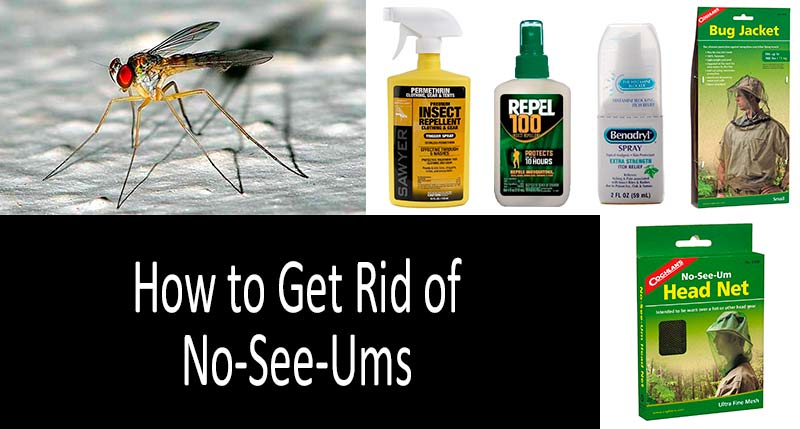
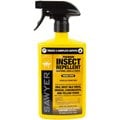
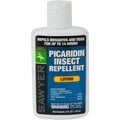
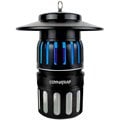

 Product Type: CO2 trap / Action: Attracts insects with UV light and CO2, sucks them inside causing their death from dehydration
Product Type: CO2 trap / Action: Attracts insects with UV light and CO2, sucks them inside causing their death from dehydration  Product Type: Bug zapper / Action: Attracts insects by UV light and killing them by electric current
Product Type: Bug zapper / Action: Attracts insects by UV light and killing them by electric current  Product Type: DEET-based repellent spray / Action: Repels all biting midges for up to 10 hours
Product Type: DEET-based repellent spray / Action: Repels all biting midges for up to 10 hours  Product Type: DEET-based repellent wipes / Action: Repels all biting midges for up to 10 hours, small packets are very mobile
Product Type: DEET-based repellent wipes / Action: Repels all biting midges for up to 10 hours, small packets are very mobile  Product Type: Picaridin-based repellent / Action: Repels all biting midges for up to 8 hours
Product Type: Picaridin-based repellent / Action: Repels all biting midges for up to 8 hours  Product Type: Permethrin-based clothing repellent / Action: Is to be applied on clothes, tents, bags, backpacks, hammocks, street furniture and mosquito nets.
Product Type: Permethrin-based clothing repellent / Action: Is to be applied on clothes, tents, bags, backpacks, hammocks, street furniture and mosquito nets.  Product Type: Net clothing / Action: Arms, body and head protection
Product Type: Net clothing / Action: Arms, body and head protection  Product Type: Net clothing / Action: Head protection
Product Type: Net clothing / Action: Head protection  Product Type: Net clothing / Action: Feet protection
Product Type: Net clothing / Action: Feet protection 